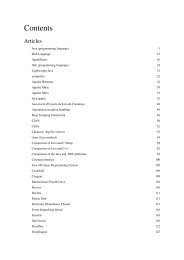Structured Query Language (SQL) - Cultural View of Technology
Structured Query Language (SQL) - Cultural View of Technology
Structured Query Language (SQL) - Cultural View of Technology
Create successful ePaper yourself
Turn your PDF publications into a flip-book with our unique Google optimized e-Paper software.
PL/<strong>SQL</strong> 74<br />
PL/<strong>SQL</strong><br />
PL/<strong>SQL</strong> (Procedural <strong>Language</strong>/<strong>Structured</strong> <strong>Query</strong> <strong>Language</strong>) is Oracle Corporation's procedural extension language<br />
for <strong>SQL</strong> and the Oracle relational database. PL/<strong>SQL</strong>'s general syntax resembles that <strong>of</strong> Ada.<br />
PL/<strong>SQL</strong> is one <strong>of</strong> three key programming languages embedded in the Oracle Database, along with <strong>SQL</strong> itself and<br />
Java.<br />
PL/<strong>SQL</strong> is available in Oracle Database (since version 7), TimesTen in-memory database (since version 11.2.1), [1]<br />
IBM DB2 (since version 9.7) [2] .<br />
Introduction<br />
PL/<strong>SQL</strong> supports variables, conditions, loops and exceptions. Arrays are also supported, though in a somewhat<br />
unusual way, involving the use <strong>of</strong> PL/<strong>SQL</strong> collections. PL/<strong>SQL</strong> collections are a slightly advanced topic.<br />
Implementations from version 8 <strong>of</strong> Oracle Database onwards have included features associated with<br />
object-orientation.<br />
PL/<strong>SQL</strong> program units (essentially code containers) can be compiled into the Oracle database. Programmers can thus<br />
embed PL/<strong>SQL</strong> units <strong>of</strong> functionality into the database directly. They also can write scripts containing PL/<strong>SQL</strong><br />
program units that can be read into the database using the Oracle <strong>SQL</strong>*Plus tool.<br />
Once the program units have been stored into the database, they become available for execution at a later time.<br />
While programmers can readily embed Data Manipulation <strong>Language</strong> (DML) statements directly into their PL/<strong>SQL</strong><br />
code using straight forward <strong>SQL</strong> statements, Data Definition <strong>Language</strong> (DDL) requires more complex "Dynamic<br />
<strong>SQL</strong>" statements to be written in the PL/<strong>SQL</strong> code. However, DML statements underpin the majority <strong>of</strong> PL/<strong>SQL</strong><br />
code in typical s<strong>of</strong>tware applications.<br />
In the case <strong>of</strong> PL/<strong>SQL</strong> dynamic <strong>SQL</strong>, early versions <strong>of</strong> the Oracle Database required the use <strong>of</strong> a complicated Oracle<br />
DBMS_<strong>SQL</strong> package library. More recent versions have however introduced a simpler "Native Dynamic <strong>SQL</strong>",<br />
along with an associated EXECUTE IMMEDIATE syntax.<br />
Oracle Corporation customarily extends package functionality with each successive release <strong>of</strong> the Oracle Database.<br />
PL/<strong>SQL</strong> program units<br />
Anonymous Blocks<br />
Anonymous blocks [3] form the basis <strong>of</strong> the simplest PL/<strong>SQL</strong> code, and have the following structure:<br />
<br />
DECLARE<br />
BEGIN<br />
EXCEPTION<br />
END label;<br />
Type / item / function / procedure declarations<br />
Statements<br />
Exception handlers<br />
The and the DECLARE and EXCEPTION sections are optional.<br />
Exceptions, errors which arise during the execution <strong>of</strong> the code, have one <strong>of</strong> two types:<br />
1. Predefined exceptions<br />
2. User-defined exceptions.










